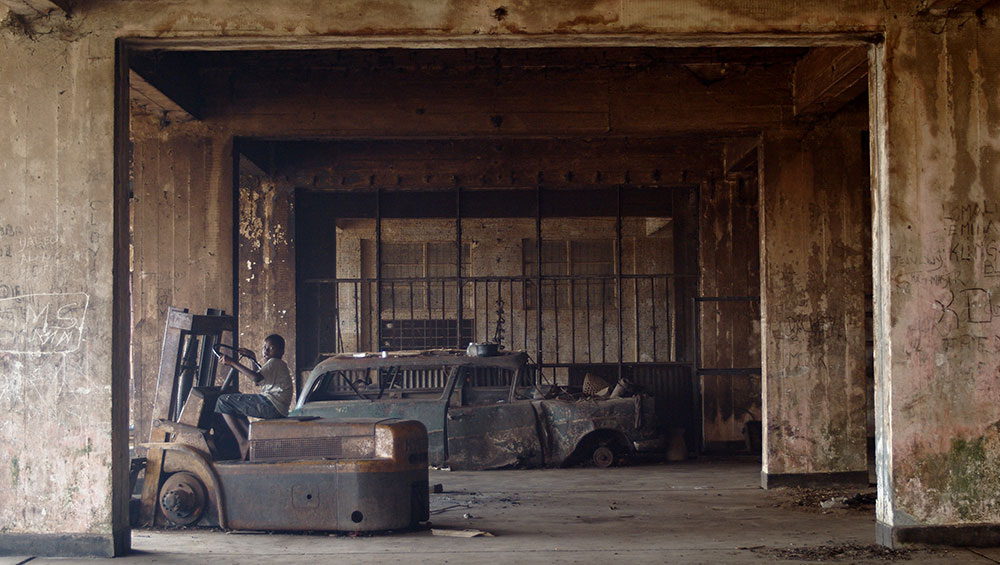
Sammy Baloji, Aequare. The Future that never was, 2023. Still. Courtesy of the artist and Galerie Imane Farès.
Goldsmiths CCA, London
4 October 2024 – 12 January 2025
by JOE LLOYD
Wood, rubber, ivory, diamonds, gold, cobalt, tin, copper, coffee, petroleum, gas, uranium, radium, tantalum: the Democratic Republic of Congo is a trove of natural resources. This has been used to justify a century and a half of brutal subjugation, from Leopold II of Belgium’s personal fiefdom to war-torn republic, exploited and extracted from by neighbouring and distant powers. The art of Sammy Baloji (b1978), who hails from the DRC’s southern Katanga province, explores the history and memory of his country, from the colonial era to present-day economic imperialism. He began as a photographer, but has since expanded into film, sculpture and works on paper.
Baloji’s well-proportioned new exhibition at Goldsmiths CCA collects five recent works, two of which are new commissions. It is a sombre, serious show, albeit not without moments of visual levity. His practice is art-as-investigation. It is research-based, involving toiling through archives and collaborating with academics. One gallery focuses on Baloji’s collaborative work with the historian Pedro Monaville and includes a presentation of printed matter relating to minerals, political pamphlets from anticolonial activities and the CIA’s infamous use of abstract expressionism in its anti-communist campaigns. There are pamphlets, poems, posters and printouts from academic texts. It sits somewhere between historical exhibit and assemblage.
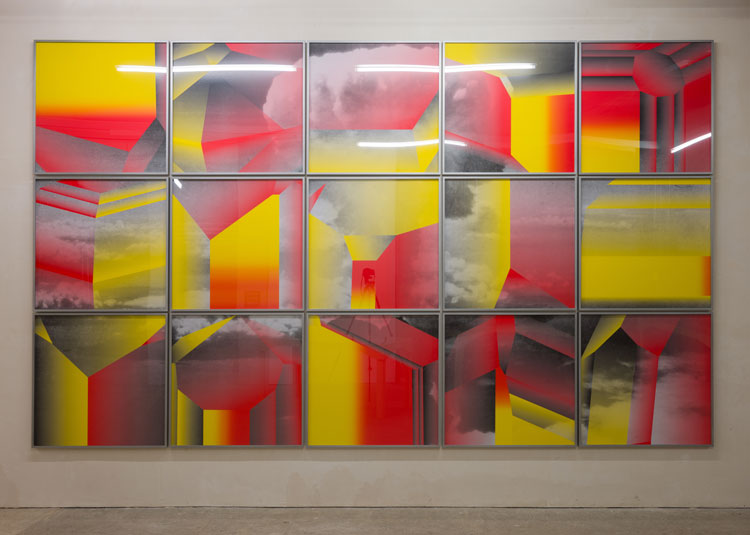
Sammy Baloji, Shinkolobwe's Abstraction, 2022. Installation view, Goldsmiths Centre for Contemporary Art, 4 October 2024 – 12 January 2025. Courtesy Goldsmiths CCA. Photo: Rob Harris.
Baloji’s works often feature myriad historical figures and systems, without knowledge of which his artwork can sometimes be elusive. A common pitfall of a research-based artist project is that the artistic outcomes can feel perfunctory, like offcuts trimmed off for the gallery floor. But Baloji’s works at Goldsmiths insist on their own primacy as pieces of art, even when surrounded by vitrines of archival material. It is a balance few artists manage to attain, and fewer sustain throughout a suite of works. In large part, Baloji succeeds. He layers referents and ideas thickly, but seldom heavy-handedly.
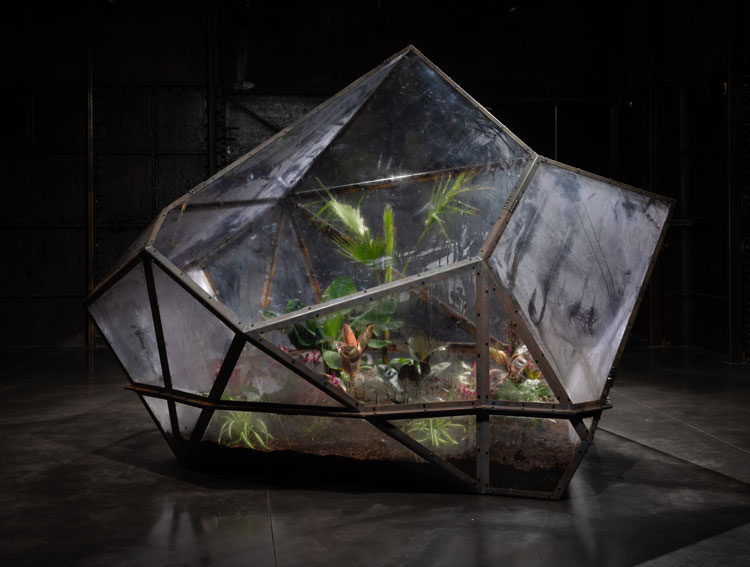
Sammy Baloji, And to Those North Sea Waves Whispering Sunken Stories (II), 2021. Installation view, Goldsmiths Centre for Contemporary Art, 4 October 2024 – 12 January 2025. Courtesy Goldsmiths CCA. Photo: Rob Harris.
Take the installation … And to Those North Sea Waves Whispering Sunken Stories (II) (2021), which has the form of a misty terrarium filled with Central African plants. It is soundtracked by blurry fragments of an audio recording of drumming and singing by Albert Kudjabo, a Congolese soldier who volunteered in the Belgian army in the first world war. He was captured by the Germans and, as prisoner of war, was subject of ethnographic study. Much like the plants treated as a tropical specimen, he was anonymised and instead classified by a racist term. The sculptural installation resembles the Wardian cases (an early type of terrarium) used to transport 19th-century botanical samples and the shape of uranium crystals. The plant trade that led to the end of pro-colonial biodiversity and the birth of the age of mutually assured destruction are wrought together, linked across time by the squeezing of Congolese minerals and flora.
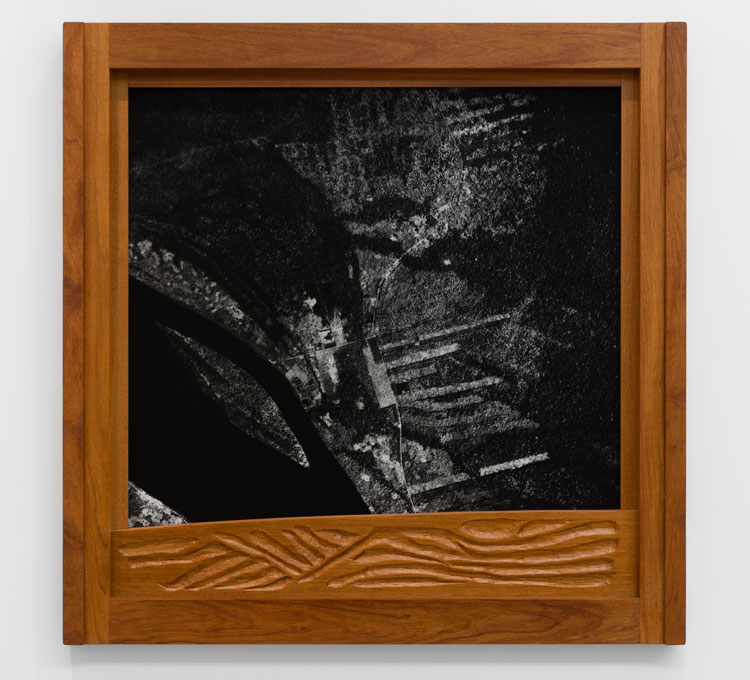
Sammy Baloji, Still Kongo I-V, 2024. Installation view (detail), Goldsmiths Centre for Contemporary Art, 4 October 2024 – 12 January 2025. Courtesy Goldsmiths CCA. Photo: Rob Harris.
Baloji’s works often stitch together stories from across time. The new commission Still Kongo I-V (2024) is a series of five prints presented in frames of Afzelia wood. The frames imitate the aesthetics of art nouveau, which flourished in Belgium in part as a result of the exploitation of the Congo, and drew on Congolese aesthetics; it was even initially known as Style Congo. Accordingly, Baloji’s frames feature patterns from objects in a travelling exhibition of Congolese art organised by Mobutu Sese Seko, dictator of Zaire, in 1975. They are created with simple means: drawing pins to create speckles of gold, nestled rectangular patterns carved into the wood.
The teak-like warmth of these frames contrasts with the black-and-white images, which are taken from a collection of photographs from 1958-59, now housed in Belgium’s Royal Museum for Central Africa, that survey the Congolese rainforest. Their purpose was to map and identify resources, but they also show the logging damage already done. And therein lies the works’ conceit. The frames and photographs are bound together in a cycle of resource transfer. Presented like paintings, the photos themselves may resemble abstract expressionism, with their bobbly forests and cleanly outlined fields, but they unmistakably show the DRC as a blemished land, treated as a vast trove by its various rulers.
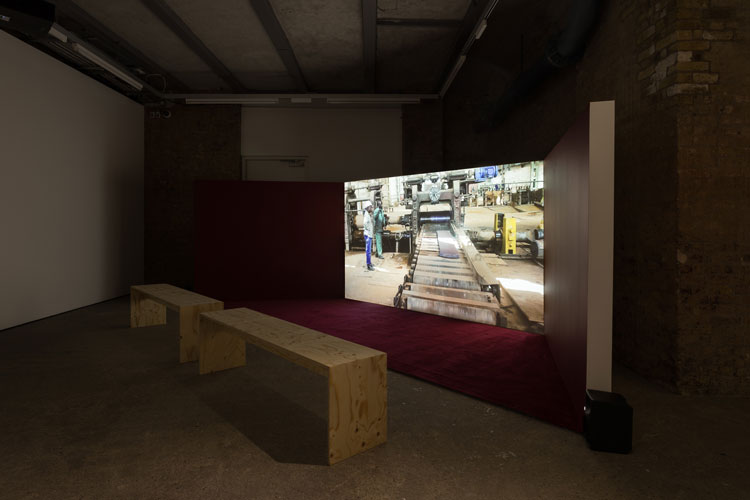
Sammy Baloji, installation view, Goldsmiths Centre for Contemporary Art, 4 October 2024 – 12 January 2025. Courtesy Goldsmiths CCA. Photo: Rob Harris.
Baloji has spoken of his “childhood experience of growing up in a city that is entirely organised around the industrial reality and exploitation of mining resources”. His film, Tales of the Copper Cross Garden, Episode 1 (2017), spends about three-quarters of an hour showing the painstaking process of melting copper into wires, like a verité spin on the TV series How It’s Made. Baloji interrupts the footage with quotes from the Congolese philosopher and poet Valentin-Yves Mudimbe’s autobiographical writings on growing up a choir boy with a colonialist father. This serves to link – along with a choral soundtrack – the Catholic church with the regime, a point perhaps forced a little bluntly by a nearby print of choirboys singing. Baloji says, in the exhibition text: “Nothing less than the copper crosses held in front of the hearts of the choir children suggest how the missionaries tried to steal their souls while exploiting the local copper resources for the benefit of Europeans.” The film lacks the clarity of his language; it is simultaneously a bit too obvious and yet too obtuse for those not familiar with Mudimbe’s work, or indeed the brand of Christian missionary activity spread in the Belgian Congo.
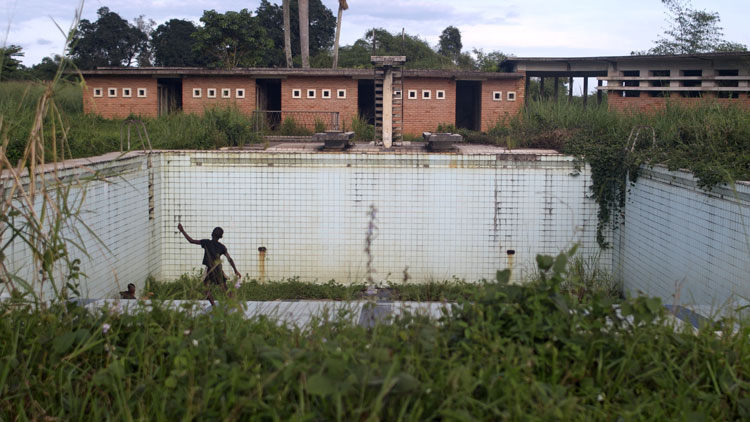
Sammy Baloji, Aequare. The Future that never was, 2023. Still. Courtesy of the artist and Galerie Imane Farès.
The eloquent Aequare. The Future that Never Was (2023), first shown at the Venice Architecture Biennale 2023, achieves a finer balance. Focused on the Yangambi, in the Congo rainforest, the world’s second largest, it flickers between propaganda film from the National Institute for Agronomic Study of the Belgian Congo and footage of its present-day successor. One offers a confected vision of a harmonious scientific community in the control of white colonists, while the other shows the contemporary reality. The architecture remains the same, albeit more careworn; the landscape is similar, albeit more scarred. The Belgian-era data gathering practices and ecological management has stayed the same. Baloji implies that colonial ecology has created a framework from which the modern DRC has yet to escape.